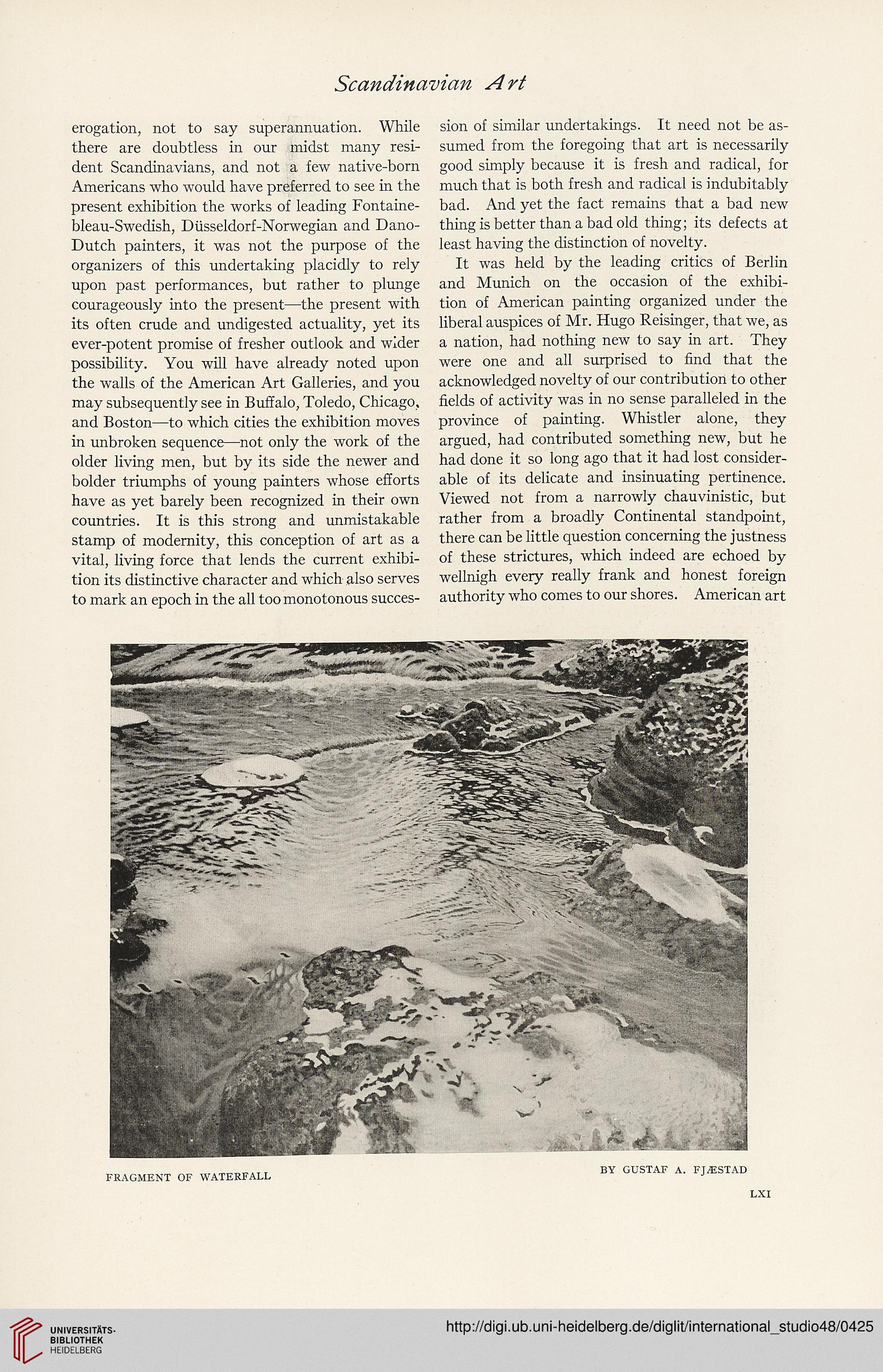Scandinavian Art
erogation, not to say superannuation. While
there are doubtless in our midst many resi-
dent Scandinavians, and not a few native-born
Americans who would have preferred to see in the
present exhibition the works of leading Fontaine-
bleau-Swedish, Dusseldorf-Norwegian and Dano-
Dutch painters, it was not the purpose of the
organizers of this undertaking placidly to rely
upon past performances, but rather to plunge
courageously into the present—the present with
its often crude and undigested actuality, yet its
ever-potent promise of fresher outlook and wider
possibility. You will have already noted upon
the walls of the American Art Galleries, and you
may subsequently see in Buffalo, Toledo, Chicago,
and Boston—to which cities the exhibition moves
in unbroken sequence—not only the work of the
older living men, but by its side the newer and
bolder triumphs of young painters whose efforts
have as yet barely been recognized in their own
countries. It is this strong and unmistakable
stamp of modernity, this conception of art as a
vital, living force that lends the current exhibi-
tion its distinctive character and which also serves
to mark an epoch in the all too monotonous succes-
sion of similar undertakings. It need not be as-
sumed from the foregoing that art is necessarily
good simply because it is fresh and radical, for
much that is both fresh and radical is indubitably
bad. And yet the fact remains that a bad new
thing is better than a bad old thing; its defects at
least having the distinction of novelty.
It was held by the leading critics of Berlin
and Munich on the occasion of the exhibi-
tion of American painting organized under the
liberal auspices of Mr. Hugo Reisinger, that we, as
a nation, had nothing new to say in art. They
were one and all surprised to find that the
acknowledged novelty of our contribution to other
fields of activity was in no sense paralleled in the
province of painting. Whistler alone, they
argued, had contributed something new, but he
had done it so long ago that it had lost consider-
able of its delicate and insinuating pertinence.
Viewed not from a narrowly chauvinistic, but
rather from a broadly Continental standpoint,
there can be little question concerning the justness
of these strictures, which indeed are echoed by
wellnigh every really frank and honest foreign
authority who comes to our shores. American art
BY GUSTAF A. FJA1STAD
FRAGMENT OF WATERFALL
LXI
erogation, not to say superannuation. While
there are doubtless in our midst many resi-
dent Scandinavians, and not a few native-born
Americans who would have preferred to see in the
present exhibition the works of leading Fontaine-
bleau-Swedish, Dusseldorf-Norwegian and Dano-
Dutch painters, it was not the purpose of the
organizers of this undertaking placidly to rely
upon past performances, but rather to plunge
courageously into the present—the present with
its often crude and undigested actuality, yet its
ever-potent promise of fresher outlook and wider
possibility. You will have already noted upon
the walls of the American Art Galleries, and you
may subsequently see in Buffalo, Toledo, Chicago,
and Boston—to which cities the exhibition moves
in unbroken sequence—not only the work of the
older living men, but by its side the newer and
bolder triumphs of young painters whose efforts
have as yet barely been recognized in their own
countries. It is this strong and unmistakable
stamp of modernity, this conception of art as a
vital, living force that lends the current exhibi-
tion its distinctive character and which also serves
to mark an epoch in the all too monotonous succes-
sion of similar undertakings. It need not be as-
sumed from the foregoing that art is necessarily
good simply because it is fresh and radical, for
much that is both fresh and radical is indubitably
bad. And yet the fact remains that a bad new
thing is better than a bad old thing; its defects at
least having the distinction of novelty.
It was held by the leading critics of Berlin
and Munich on the occasion of the exhibi-
tion of American painting organized under the
liberal auspices of Mr. Hugo Reisinger, that we, as
a nation, had nothing new to say in art. They
were one and all surprised to find that the
acknowledged novelty of our contribution to other
fields of activity was in no sense paralleled in the
province of painting. Whistler alone, they
argued, had contributed something new, but he
had done it so long ago that it had lost consider-
able of its delicate and insinuating pertinence.
Viewed not from a narrowly chauvinistic, but
rather from a broadly Continental standpoint,
there can be little question concerning the justness
of these strictures, which indeed are echoed by
wellnigh every really frank and honest foreign
authority who comes to our shores. American art
BY GUSTAF A. FJA1STAD
FRAGMENT OF WATERFALL
LXI




